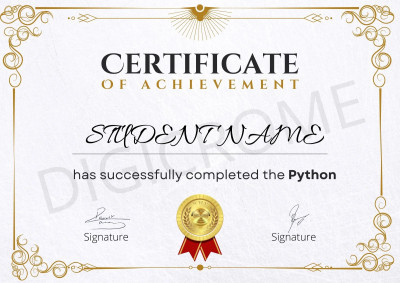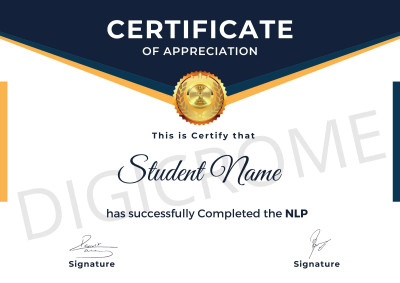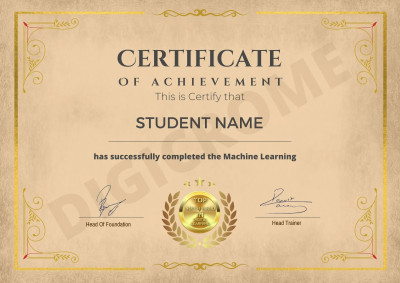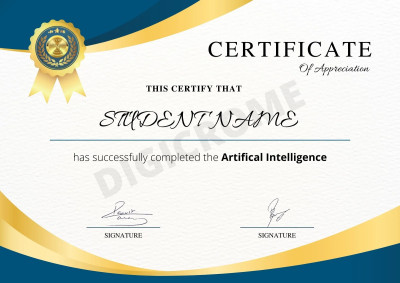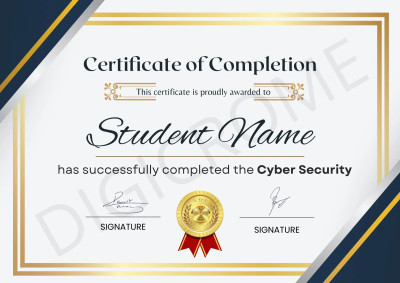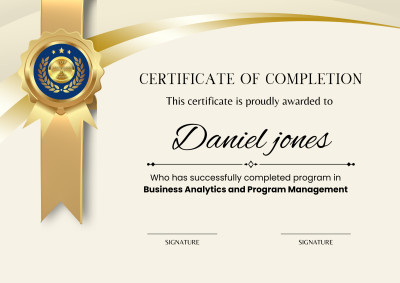Program Overview
In today's digital landscape, cybersecurity stands as a paramount necessity in safeguarding sensitive information and thwarting cyber threats. At Digicrome, we offer an all-encompassing cybersecurity course program tailored to nurture aspiring Cyber Security Professionals and propel their careers to new heights. Our program equips individuals with the essential knowledge and skills vital for success in the dynamic realm of cybersecurity. Here's a glimpse into our comprehensive curriculum:
Introduction to Cybersecurity:
Gain insights into cybersecurity fundamentals, terminology, and its pivotal role in the digital age.
Network Security:
Master the art of securing network infrastructure and defending against diverse network-based attacks.
Systems Security:
Explore system architecture, operating system security, and strategies for mitigating system vulnerabilities.
Threat Intelligence:
Dive into intelligence analysis principles applied to cyberspace, enabling proactive threat assessment and risk mitigation.
Governance, Risk Management, and Compliance:
Navigate governance frameworks, risk management processes, and compliance standards vital for ensuring information system security.
Logs & Detection:
Learn to analyze logs from various network devices to detect and respond effectively to security incidents.
Python for Cybersecurity:
Acquire foundational Python programming skills and leverage its power in automating tasks and analyzing security-related data.
Application Security and Penetration Testing:
Explore application vulnerabilities and penetration testing techniques to fortify applications against cyber threats.
Cryptography and Encryption:
Delve into cryptography principles and applications, securing communication protocols and data encryption.
Capstone Project:
Engage in a real-world cybersecurity project, applying acquired knowledge and skills to solve complex challenges and present findings professionally.
Digicrome's cybersecurity course program offers a holistic training experience across various domains, empowering students for lucrative careers in cybersecurity. Join us to embark on a journey of knowledge, skill development, and career advancement in the ever-evolving field of cybersecurity.
Cybersecurity Job Oriented Certificate Program
- ₹70000.00
Features
- 24 - Weeks
- Live Online
- Student Handouts
- Industrial Projects
Key Highlights
 24 - Weeks
24 - Weeks Live Online
Live Online Student Handouts
Student Handouts
 Industrial Projects
Industrial Projects
 2 Months Certified Internship
2 Months Certified Internship
 1 on 1 Mentorship
1 on 1 Mentorship
 Experienced Faculties
Experienced Faculties
 Career Counselling Support
Career Counselling Support
Program Objective
- Introduction, Computer Security, Threats, Harm, Vulnerabilities, Controls, Authentication, Access Control and Cryptography.
- Web attack: Browser Attacks, Web Attacks Targeting Users, Obtaining User or Website Data, Email Attacks.
- Network Vulnerabilities: Overview of vulnerability scanning, Open Port / Service Identification, Banner /Version Check, Traffic Probe, Vulnerability Probe, Vulnerability Examples, OpenVAS, Metasploit.
- Networks Vulnerability Scanning (Netcat, Socat), Network Sniffers and Injection tools
- Firewalls and Packet Filters: Firewall Basics, Packet Filter Vs Firewall, How a Firewall Protects a Network, Packet Characteristic to Filter, Stateless Vs Stateful Firewalls, Network Address Translation (NAT) and Port Forwarding.
- VPN: the basic of Virtual Private Networks.
- Firewall: Introduction, Linux Firewall, Windows Firewall.
- Snort: Introduction Detection System.
- Scanning for web vulnerabilities tools: Nikto, W3af.
- HTTP utilities - Curl, OpenSSL and Stunnel.
- Application Inspection tools – Zed Attack Proxy, Sqlmap, DVWA, Webgoat.
- Password Cracking and Brute-Force Tools: John the Ripper, L0htcrack, Pwdump, HTC-Hydra.
- Cyber Crimes, Types of Cybercrime, Hacking, Attack vectors, Cyberspace and Criminal Behavior, Clarification of Terms, Traditional Problems Associated with Computer Crime, Introduction to Incident Response, Digital Forensics, Computer Language, Network Language, Realms of the Cyber world.
- Internet crime and Act: A Brief History of the Internet, Recognizing and Defining Computer Crime, Contemporary Crimes, Computers as Targets, Contaminants and Destruction of Data
- Firewalls and Packet Filters, password Cracking, Keyloggers and Spyware, Viruses and Warms, Trojan and backdoors, Steganography, DOS and DDOS attacks, SQL injection, Buffer Overflow, and Attacks on wireless Networks.
- Introduction to Networking, Components of Networking, Different Computing Models of Network, Centralized, Distributed, Collaborative, Networking Configuration Client/Server Based, Peer To Peer Networking, Local and Wide Area Networks.
- Intranets and Internets Network Services, FileServices, File Transfer Services, Printing Services, Application Services.
- Fundamentals of communication theory, Analog and Digital Signal, Periodic aperiodic signal, Peak Amplitude, bit rate, frequency, Decibel, bit Interval, Transmission Impairment, Attenuation, Distortion, Noise, thermal, Induced, cross talk, Impulse Noise.
- Throughput, Propagation Speed, waveforms, bandwidth.
- Introduction to Standards, Standard Organization and the OSI rules and the Communication Process.
- The OSI reference Model, How the Peer OSI Layer Communicates, and Protocol Stacks.
- The OSI reference Model, How the Peer OSI Layer Communicates, and Protocol Stacks.
- IEEE802 family standard
- Introduction to Transmission Media, Characteristics, Cost, Installation, Requirements, Bandwidth Band Usage, Attenuation and Electromagnetic Interference.
- Cable Media Coaxial Cable, Twisted-Pair Cable, Fiber Optic Cable, Summary of Cable.
- Wireless Media, Reason for Wireless Network, Wireless Communication with LANs, Comparison of Different Wireless Media, Time Division Multiplexing (TDM), Time Division Multiple Access (TDMA).
- TCP/IP: TCP/IP and internetworking, related protocols, ports and sockets, The IP address structure, IP datagram.
- Connectivity Devices: Introduction to Modems, Asynchronous Transmission, Synchronous Transmission, Network Adapter card, Repeaters Hubs Passive, Active, Intelligent, Bridges, Routers, Brouters, Gateways, Routing Algorithms, Distance Vector Routing, Link State Routing.
- Network architectures: Introduction to Access Methods, Contention Polling, Token Passing, Comparing Contention and Token Passing, Demand Priority.
- Topologies: Network Topologies, Bus Topologies, Ring Topologies and Star Topologies, Mesh Topology.
- Switching & Routing In Networks: Message Switching, Packet switching when and when not to use packet switching, packet routing, and packet switching support to circuit switching.
- Enviornment Setup
- The Fundamentals Variables Strings Error Handling If While Loop For Loop Dictionaries Functions Inventory
- OOP Importing Packages Create your class with functions and import and use it from another file.
- API Requests
- Sockets and Cybersecurity
- Build a mock login application in Python using sockets
- Hashing and Bcrypt Setup
- Implementing Hashing
- Manipulating Headers - Pretending to be a Googlebot
- GitHub API Project Setup and Requirements
- Sending Emails with Python
- Computational Complexity GCD Computation Finite Groups
- Modular Arithmetic Key Exchange Public Key Cryptosystem
- Factorization Primarily Testing Elliptic Curve Cryptosystem
- Hash Function Digital Signatures Stream Ciphers
- Information security standards Information security regulations Industry best practices Industry best practices.
- Managing information security management system - iso standards ISO/IEC 27001 and 27002 for information security management system (isms) Information security management system (isms) auditing.
- Security audit Information security Disaster recovery Business continuity planning and management.
- Packet Analysis & Risk Management Wireless Network Analysis Intrusion Detection & Prevention System Cyber Crime. IT Assets and Wireless Security.
- Malware Analysis Email Security Analysis Vulnerability Assessment and Penetration Testing (VPAT).
- Cyber Security Incident Management Handling an Incident Coordination and Information Sharing Containment, Eradication and Recovery.
- Cyberspace – An Overview of the Concept Inherent Characteristics of Cyberspace Cyberspace Regulatory Theory of Lawrence Lessig.
- Outline of Legislative Framework for Cyber Law History and Emergence of Cyber Law Outreach and Impact of Cyber Law.
- Establishment of Personal Jurisdiction in Cyberspace Overview of Tests and Interactivity Jurisdictional Approaches of Online Contract Basis of Jurisdiction and Indian Approach.
- Freedom of Expression Examination of Rights Under Laws The Legislative Responses in Cyberspace.
- Cover the fundamentals of key issues in the information security world, including the basics of ethical hacking, information security controls, relevant laws, and standard procedures.
- Learn how to use the latest techniques and tools to perform foot printing and reconnaissance, a critical pre-attack phase of the ethical hacking process.
- Learn different network scanning techniques and countermeasures.
- Learn various enumeration techniques, such as Border Gateway Protocol (BGP) and Network File Sharing (NFS) exploits, and associated countermeasures.
- Learn how to identify security loopholes in a target organization’s network, communication infrastructure, and end systems. Different types of vulnerability assessment and vulnerability assessment tools.
- Learn about the various system hacking methodologies—including steganography, steganalysis attacks, and covering tracks—used to discover system and network vulnerabilities.
- Learn different types of malware (Trojan, viruses, worms, etc.), APT and fileless malware, malware analysis procedure, and malware countermeasures.
- Learn about packet-sniffing techniques and how to use them to discover network vulnerabilities, as well as countermeasures to defend against sniffing attacks.
- Learn social engineering concepts and techniques, including how to identify theft attempts, audit human-level vulnerabilities, and suggest social engineering countermeasures.
- Learn about different Denial of Service (DoS) and Distributed DoS (DDoS) attack techniques, as well as the tools used to audit a target and devise DoS and DDoS countermeasures and protections.
- Understand the various session hijacking techniques used to discover network-level session management, authentication, authorization, and cryptographic weaknesses and associated countermeasures.
- Get introduced to firewalls, intrusion detection systems (IDS), and honeypot evasion techniques; the tools used to audit a network perimeter for weaknesses; and countermeasures.
- Learn about web server attacks, including a comprehensive attack methodology used to audit vulnerabilities in web server infrastructures and countermeasures.
- Learn about web application attacks, including a comprehensive web application hacking methodology used to audit vulnerabilities in web applications and countermeasures.
- Learn about SQL injection attacks, evasion techniques, and SQL injection countermeasures.
- Understand different types of wireless technologies, including encryption, threats, hacking methodologies, hacking tools, Wi-Fi security tools, and countermeasures.
- Learn Mobile platform attack vectors, android and iOS hacking, mobile device management, mobile security guidelines, and security tools.
- Learn different types of IoT and OT attacks, hacking methodology, hacking tools, and countermeasures.
- Learn different cloud computing concepts, such as container technologies and serverless computing, various cloud computing threats, attacks, hacking methodology, and cloud security techniques and tools.
- Learn about encryption algorithms, cryptography tools, Public Key Infrastructure (PKI), email encryption, disk encryption, cryptography attacks, and cryptanalysis tools.
- Cryptography and Information Theory
- Symmetric Cryptography
- Cryptographic Hash and Integrity Protection
- Cyber Security - Case Study
- Cyber Security - Dissertation Proposal
- Application Areas & Related Tools
- Case Study/Dissertation Report
- Forage
- Training by industry expert trainers
Our Certificates
Certified by









